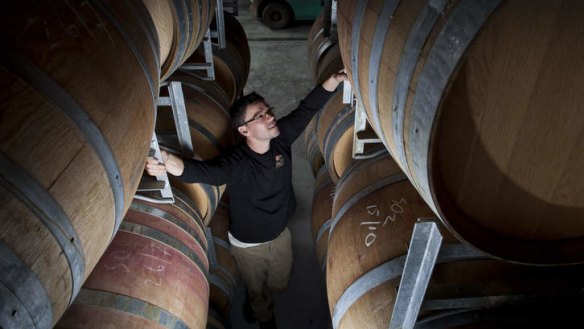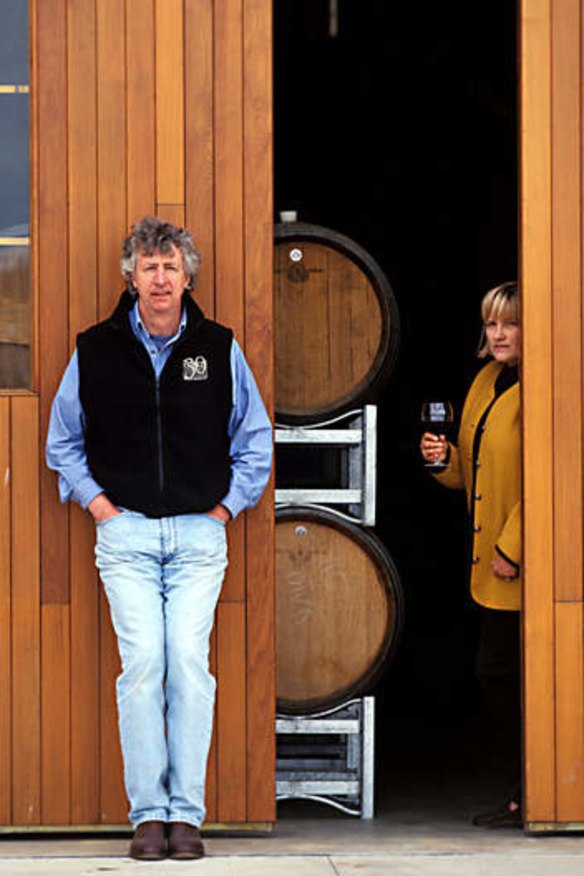Cracking the great oak algorithm
The master of minutiae is driven by passion and perfection.

IN 2004, AND EVERY YEAR SINCE, Phillip Moraghan has set aside time post-vintage to taste each barrel of new wine at his Curly Flat winery, outside the town of Lancefield.
That's not unusual - tasting wine as it progresses through all levels of winemaking is essential. It's how Moraghan goes about the task that's different.
Most producers wait until a wine is in the bottle and out in the marketplace before they send it off for judging at a wine show, but Moraghan brings the wine judging into his winery to appraise every new wine to barrel.

The four-man panel consists of Moraghan, winery manager Matt Regan, assistant winemaker Ben Kimmorley and consultant/wine judge Robert Paul.
The barrel samples are tasted blind and in silence.
The men probably draw the line at donning white coats - the essential wine-judging accoutrement - but you can't be sure. This is serious business.
Scores are declared. Debates rage.
Finally, the identity of the sample is revealed and stored in the Oak Master File. Logged in are the individual ferment number, the oak supplier, the age of the oak, and many more details. Moraghan loves minutiae. But the funny thing is, after all this hard work, Curly Flat chardonnay and pinot noir, acknowledged as some of the best in the state - possibly the country - do not show obvious oak manipulation.
Oak is one small part of the whole and in Phillip Moraghan's wine world, there are many, many small parts.
He has stats and figures, charts and photos detailing every aspect of his wine growing and making going back to the start in 1989. He even takes photos of wine bugs as they appear under the microscope, ''so we can compare them with next year's'', he says. ''We like our lab toys.''
You've got to appreciate his passion, the detail to attention and absolute dedication to the stuff we open and often down with barely a thought as to how it got there. If we don't care for the fine detail, that's OK, Moraghan's got our back.
For a recent tasting of every wine he has made over 15 vintages, he produced a bulging 117-page dossier on his journey.
It's been a long and curvy journey, from deserting the corporate world to apprenticeships under pinot noir winemaker Gary Farr, and some of the leading producers of Oregon and Burgundy (Ponzi, Domaine de Montille, Jean-Marc Pillot), to embracing biodynamic wine growing and making, and, of course, the search for the great ''oak algorithm''.
Then there's the enduring question - when to pick? ''I can taste when it's wrong to pick,'' he says. ''I can't taste when it's right to pick.''
If Moraghan didn't make pinot noir, his chardonnay would be lauded as the principal wine. But he does make pinot noir, very well, leaving his chardonnay just that little under-appreciated.
It is a complex wine. The house style, weightier and more intense than many, was there going back to the first vintage in 1998, but it was in 2004 that you began to see a tinkering of the acid structure and, yes, oak. The acid becomes softer and the oak begins to melt into the wine, coming together beautifully in 2006.
In 2010, there was another tweak: wild, dirty, herbal. It's like watching the transition from adolescence into adulthood, a major milestone being marked.
Curly Flat's ''junior'' chardonnay, Lacuna, deals with the oak algorithm by leaving it out altogether. It is the ying to the wooded yang of the flagship, pushing the grape's citrus and acid to the fore. It can be quite delicious and fresh.
Pinot noir is the dominant variety, representing 69 per cent of the plantings, or 8.48 hectares. I could detail the clones and when each new clone was planted, but it's enough to say that by 2000, Curly Flat had a healthy selection of old reliables (MV6, D5V12) and trendy newcomers (114, 115).
Pinot is made in small lots, up to 35 of them some vintages. On the great ''whole bunch or not'' debate, Moraghan falls on the side of using some whole bunches to enhance the fruit lift, mouth feel and tannin structure. Since 2003, pinot has been kick-started into fermentation by natural yeasts.
All of this doesn't really give you too much of an idea of style because the vineyard does its bit, too.
The timeline for 15 vintages of Curly Flat pinot starts a little like dry red (or at least the 1998 looks that way today), moves into a bracket where the wines are posting lots of bitter chocolate and black cherries (not a bad thing), and then in 2001 comes a burst of beautiful fragrance with herbal undertones - very fine indeed. By 2004, there's some added spice and the middle palate is gaining texture, culminating in the seamless and supple 2005 and 2006 pinots (I can't, and don't want to, separate them on quality).
As in the Curly Flat chardonnay, the 2010 pinot noir seems to mark a watershed year with the appearance of cardamom and the most exotic Indian spices.
It seems almost trite to call Curly Flat's Williams Crossing pinot noir the company's ''junior'' pinot because it is among the best value-for-money pinots going, a rollicking good drinking that many a winemaker would like to call their own.
And there's more.
In 2011, Phillip Moraghan embraced a juicy, light, dry, red pinot, a nod to Beaujolais that he called Chene Des Beaux Monts. As the winemaker says, ''Everything at Curly Flat is a work in progress.''
Just imagine the size of the dossier and what he will be showing us in another 15 years.